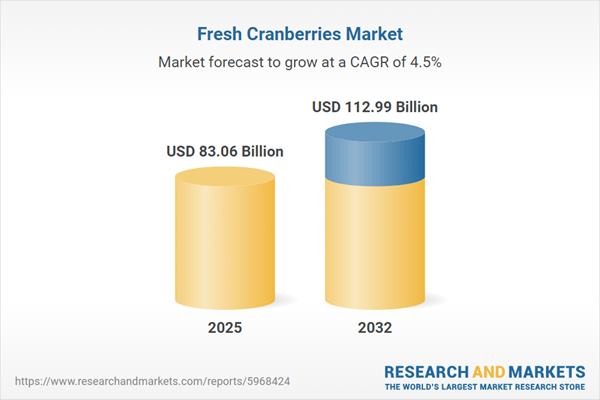Speak directly to the analyst to clarify any post sales queries you may have.
The fresh cranberries market is entering a new phase, driven by executive strategies around resilient procurement, digital transformation, and sustainable practices. Senior decision-makers are steering sourcing models and operational processes to align with modern market demands and a rapidly shifting global landscape.
Market Snapshot: Fresh Cranberries Market Growth Outlook
The global fresh cranberries market is projected to reach USD 79.40 billion in 2024, advancing with a compound annual growth rate of 4.50%. This ongoing growth positions the market to achieve USD 83.06 billion by 2025 and reach USD 112.99 billion by 2032. Expansion is fueled by changing consumer preferences that prioritize health and wellness, together with increased momentum towards sustainability across the sector. Suppliers are directing investments toward digital visibility platforms, improving transparency in procurement, and optimizing supply chains. In the context of diverse value chains and regional variances, advanced analytics and adaptive distribution strategies are being leveraged to sustain operational performance and respond proactively to evolving market conditions.
Scope & Segmentation in the Fresh Cranberries Market
This market research equips procurement leaders and executives with essential segmentation and benchmarking tools to refine sourcing strategies and sharpen competitive positions. Advances in technology, infrastructure development, and stakeholder demands continue to shape the market’s complexity and opportunities:
- Purchase Mode: Utilize both open and pre-packaged options to achieve operational flexibility, manage inventory efficiently, and adapt delivery to different customer needs.
- Product Type: Integrate both conventional and organic offerings to align with sustainability goals and evolving consumer expectations, maintaining compliance with regulatory and stakeholder requirements.
- Packaging Format: Deploy bulk, clamshell, and sleeve packaging to balance buyer volume requirements and enhance retail shelf life, presentation, and product freshness.
- Distribution Channel: Optimize market coverage through supermarkets, foodservice operators, specialty stores, convenience channels, direct-to-consumer strategies, and e-commerce, ensuring extensive market reach and timely response.
- Application: Leverage fresh cranberries in culinary, beverage, and industrial uses, supporting product diversification and broader market penetration for different end users.
- Geography: Analyze market performance and entry strategies across the Americas, Europe, Middle East & Africa, and Asia-Pacific, accounting for unique regional regulations, infrastructure capacities, and procurement challenges.
- Key Companies: Evaluate strategies of major players such as Ocean Spray Cranberries, Decas Cranberry Products, InHarvest, J.J. Vena, and Dole Food Company, with focus on integration and innovation meeting sector demands.
Key Takeaways for Senior Decision-Makers
- Sustainability certifications shape closer supplier collaborations and elevate compliance requirements across the supply chain for the fresh cranberries sector.
- Modern digital tools and advanced analytics allow procurement teams to take data-driven, flexible approaches and accelerate responses to market fluctuations.
- Diversified digital procurement and expanded B2B distribution channels foster resilient global supply networks and new partnership opportunities.
- Innovative packaging options are central to improving product protection, waste reduction, and reliable logistics while managing costs and maintaining product quality.
- Adapting strategies by region enhances local competitiveness, addresses specific regulatory and demographic factors, and strengthens risk management for market entry and expansion.
- Continual investment in digital advancements and sustainability builds the foundation for operational resilience and solid long-term positioning as market conditions shift.
Tariff Impact: Navigating New Trade Pressures
With fresh U.S. tariffs anticipated in 2025, organizations are proactively reviewing supplier contracts and examining alternative sourcing opportunities. Strategic agility and comprehensive risk assessment are critical for maintaining supply continuity and safeguarding margins as global trade dynamics evolve in the coming period.
Methodology & Data Sources
This report is grounded in insights from executive interviews, in-depth secondary research, and regulatory analysis. Application of data triangulation, SWOT analysis, and detailed supply chain mapping delivers robust, actionable intelligence for decision-makers.
Why This Fresh Cranberries Market Report Matters
- Supports executives with up-to-date insights to recalibrate procurement and operational strategies in line with market trends and digital advancements.
- Unveils pathways for efficiency improvements and growth, fostering leadership in process optimization and sustainability integration.
- Enables organizations to anticipate regulatory changes and adapt to dynamic consumer preferences, encouraging agile, future-ready decision-making.
Conclusion
Prioritizing advanced supply chain solutions, analytics, and sustainability efforts will underpin ongoing competitiveness in the fresh cranberries market. Strategic focus in these domains equips organizations to adapt and succeed amid evolving sector landscapes.
Additional Product Information:
- Purchase of this report includes 1 year online access with quarterly updates.
- This report can be updated on request. Please contact our Customer Experience team using the Ask a Question widget on our website.
Table of Contents
3. Executive Summary
4. Market Overview
7. Cumulative Impact of Artificial Intelligence 2025
Companies Mentioned
The companies profiled in this Fresh Cranberries market report include:- Ocean Spray Cranberries, Inc.
- Decas Cranberry Products, Inc.
- InHarvest, LLC
- J.J. Vena, Inc.
- Dole Food Company, Inc.
Table Information
| Report Attribute | Details |
|---|---|
| No. of Pages | 181 |
| Published | October 2025 |
| Forecast Period | 2025 - 2032 |
| Estimated Market Value ( USD | $ 83.06 Billion |
| Forecasted Market Value ( USD | $ 112.99 Billion |
| Compound Annual Growth Rate | 4.5% |
| Regions Covered | Global |
| No. of Companies Mentioned | 6 |









